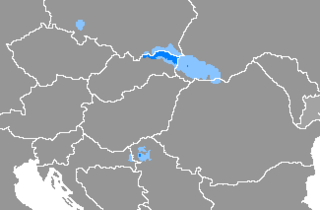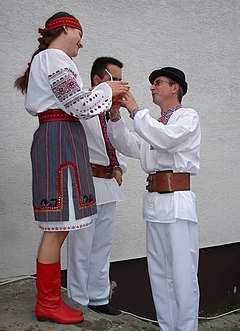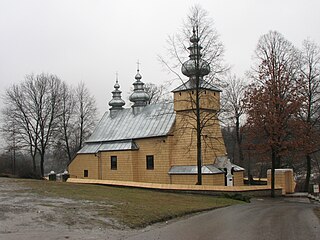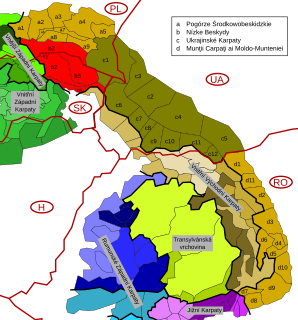
The Rusyn language, also known by the older term, руснацькый язык, rusnac'kyj jazyk, 'Rusnak language', is an East Slavic language spoken by Rusyns in several parts of Central and Eastern Europe, and written in the Cyrillic script. The majority of speakers live in an area that spans from Transcarpathia, westward into eastern Slovakia and south-east Poland. There is also a sizeable linguistic island in the Vojvodina, Serbia and a Rusyn diaspora throughout the world. Per the European Charter for Regional or Minority Languages, Rusyn is officially recognized as a protected minority language by Bosnia and Herzegovina, Croatia, Hungary, Romania, Poland, Serbia, and Slovakia.

Ruthenian and Ruthene are exonyms of Latin origin, formerly used in Eastern and Central Europe as common ethnonyms for East Slavs, particularly during the late medieval and early modern periods. Latin term Rutheni was found in medieval sources to describe all Eastern Slavs of the Grand Duchy of Lithuania, as an exonym for people of the former Kievan Rus', thus including ancestors of the modern Russians, Ukrainians, Rusyns, and Belarusians. The use of Ruthenian and related exonyms continued through the early modern period, developing several distinctive meanings, both in terms of their regional scopes and additional religious connotations.

Sanok is a town in the Subcarpathian Voivodeship of south-eastern Poland with 38,397 inhabitants, as of June 2016. Located on the San River and around 52 km south of Przemyśl, Sanok lies directly by the Carpathian Mountains.

Lemkos are an ethnic group inhabiting the Lemko Region of Carpathian Rus', an ethnographic region in the Carpathian Mountains and foothills spanning Ukraine, Slovakia and Poland.

Rusyns, also known as Carpatho-Rusyns, or Rusnaks, are an East Slavic ethnic group from the Eastern Carpathians in Central Europe. They speak Rusyn, an East Slavic language variety, treated variously as either a distinct language or a dialect of the Ukrainian language. As traditional adherents of Eastern Christianity, the majority of Rusyns are Eastern Catholics, though a minority of Rusyns still practice Eastern Orthodoxy. Rusyns primarily self-identify as a distinct Slavic people and they are recognized as such in Croatia, Hungary, Poland, Romania, Serbia, and Slovakia, where they have official minority status. Alternatively, some identify more closely with their country of residence: as Polish, Slovak, or Ukrainian.

Operation Vistula was a codename for the 1947 forced resettlement of Ukrainians, Boykos, and Lemkos from the south-eastern provinces of post-war Poland, to the Recovered Territories in the west of the country. The action was carried out by the Soviet-installed Polish communist authorities with the aim of removing material support and assistance to the Ukrainian Insurgent Army. The Ukrainian Insurgent Army continued its guerilla activities until 1947 in both Subcarpathian and Lublin Voivodeships with no hope for any peaceful resolution. Operation Vistula effectively brought an end to the hostilities.

The Lemko Region is an ethnographic area in southern Poland that has traditionally been inhabited by the Lemko people. The land stretches approximately 140 km (87 mi) long and 25–50 km (16–31 mi) wide along the north side of the Carpathian Mountains, following the Polish-Slovak border from the Poprad River. In the East, the region is described as either terminating linguistically between the Wisłok River Wisłok and Osława Rivers, or ethnographically at the Sanok River, where it meets the Boyko region. Some even go so far as to consider it to extend south into the Prešov Region, Slovakia.

Binczarowa is a village in southern Poland. It is parallel to the stream known as Binczarce.

Komańcza is a village in the Sanok County, in the Subcarpathian Voivodeship (province) of south-eastern Poland. It is situated in the Bukowsko Upland mountains, located near the towns of Medzilaborce and Palota.

Lemko-Rusyn People's Republic, often known as the Lemko-Rusyn Republic or the Lemko Republic, was a short-lived state founded on 5 December 1918 in the aftermath of World War I and the dissolution of the Austro-Hungarian Empire. It was centered on Florynka, a village in the south-east of present-day Poland. Being Russophile, its intent was unification with a democratic Russia and was opposed to a union with the West Ukrainian People's Republic. A union with Russia proved impossible, so the Republic then attempted to join Subcarpathian Rus' as an autonomous province of Czechoslovakia. This, however, was opposed by the then governor of Subcarpathian Rus', Gregory Žatkovich.

The Komancza Republic, also known as the Eastern Lemko Republic, Vyslik Republic, and Lemko Republic, was a short-lived microstate, an association of thirty three Lemko villages, seated in Komańcza in the east of the Lemko Region, that existed between 4 November 1918 and 24 January 1919. It was headed by Head of the Council Rev. Panteleymon Shpylka.
Petro Trochanowski or Piotr Trochanowski was born in Parchów, Silesia in the southwestern part of Poland to Lemko parents from Binczarowa. He is the editor of Besida, published in Krynica since 1989. He is a spokesperson for the Lemko ethnic group in Poland and internationally. He is also published under the pseudonym Petro Murianka.
Metodyj Trochanovskij was a Lemko activist and teacher.

The Low Beskids or Central Beskids are a mountain range in southeastern Poland and northeastern Slovakia. They constitute a middle (central) section of the Beskids, within the Outer Eastern Carpathians.
Nieznajowa is a depopulated village in the administrative district of Gmina Sękowa, within Gorlice County, Lesser Poland Voivodeship, in southern Poland, close to the border with Slovakia. It lies approximately 19 kilometres (12 mi) south-east of Sękowa, 24 km (15 mi) south-east of Gorlice, and 123 km (76 mi) south-east of the regional capital Kraków.

Olchowiec is a village in the administrative district of Gmina Dukla, within Krosno County, Subcarpathian Voivodeship, in south-eastern Poland, close to the border with Slovakia. It lies approximately 12 kilometres (7 mi) south-west of Dukla, 26 km (16 mi) south-west of Krosno, and 69 km (43 mi) south-west of the regional capital Rzeszów.

Lalin is a village in the administrative district of Gmina Sanok, within Sanok County, Subcarpathian Voivodeship, in south-eastern Poland. It lies approximately 13 kilometres (8 mi) north-west of Sanok and 45 km (28 mi) south of the regional capital Rzeszów.

The Apostolic Exarchate of Łemkowszczyzna was a short-lived missionary pre-diocesan jurisdiction of the Ukrainian Greek Catholic Church, which was created as the Apostolic Administration of Łemkowszczyzna and then promoted as an Apostolic Exarchate. The erection of the jurisdiction was in response to the question of the national character of the Lemko people, a dispute between a pro-Ukrainian party and a Lemko nationalist party. The Eparchy of Przemyśl was pro-Ukrainian while the Polish government was opposed to Ukrainianization. Of a population of 140,000, more than 18,000 Lemko nationalists joined the Orthodox Church in opposition to the Przemyśl Eparchy. At the demand of the Polish government and to curtail losses to the Orthodox, the Holy See established a separate Apostolic Administration for the Lemkos. Poland's defeat and occupation in 1939 allowed for the appointment of the pro-Ukrainian Msgr. Oleksandr Malynovskyi as leader of the jurisdiction when a vacancy occurred in 1941.

Khrystyna Ivanivna Soloviy is a Ukrainian-Lemko folk singer.















